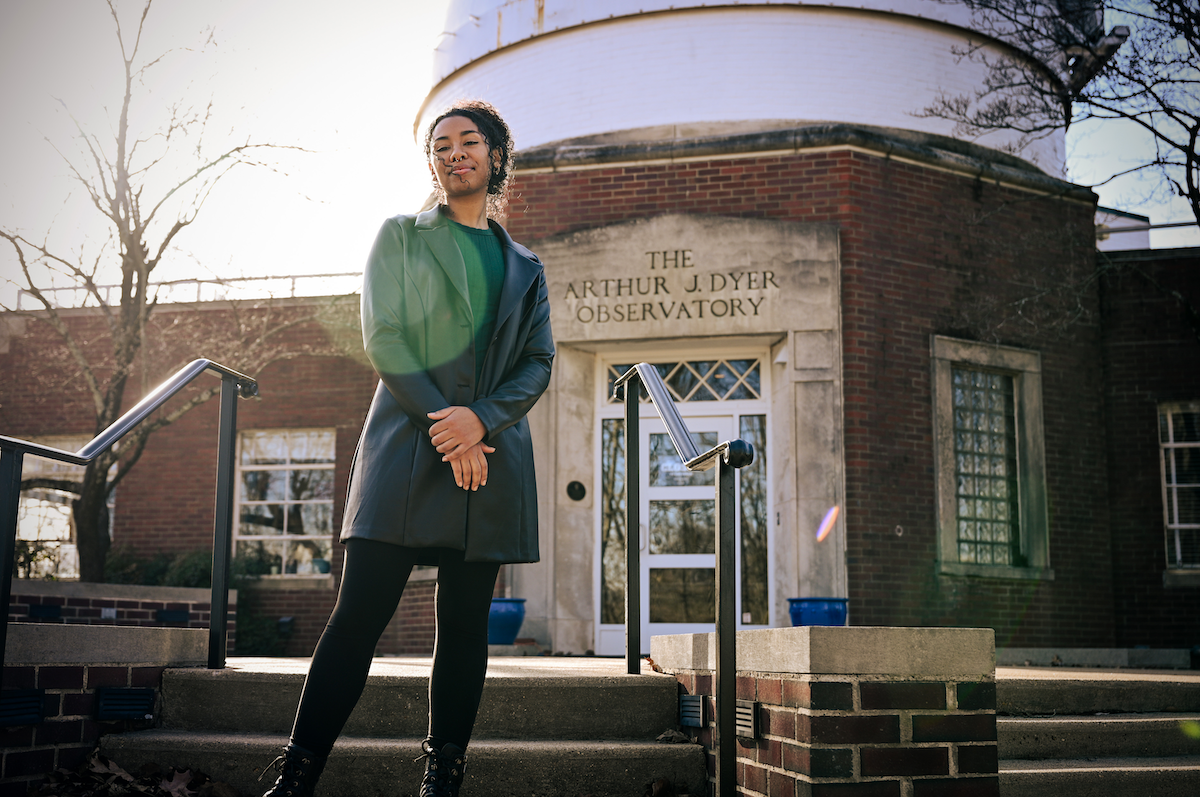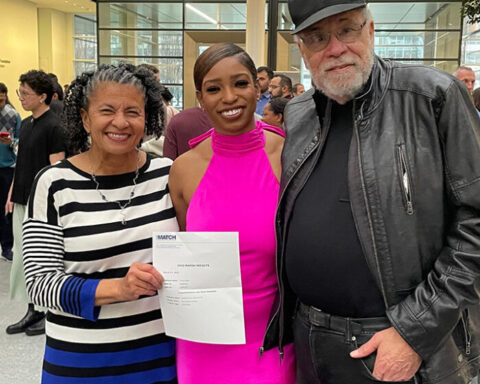Courtesy of Liz Chagnon
As a child, Shaniya Jarrett was fascinated by space and science fiction, but didn’t believe that pursuing the big scientific questions of the universe was a viable career option. Now a second-year astrophysics graduate student in the Fisk-Vanderbilt Master’s-to-Ph.D. Bridge Program, Shaniya is creating opportunities for young women of color that she would have hoped for in her own formative years.
In June 2023, Shaniya worked closely with the Vanderbilt Black Girls Becoming Summer Research Institute. Through her work, Shaniya realized there was a need to expose Black girls to science in a way that would be both accessible and appealing. “Nashville has such a large Black community and it’s so musically inclined, but there aren’t a lot of opportunities for middle-school girls to learn about astronomy and physics,” said Shaniya.
So her innovative idea was born: Shaniya created a community outreach project that introduces Black girls to astronomy by incorporating music. AstroBeats: Sounds of the Cosmos brings together local middle-school Black girls to translate NASA data into unique musical compositions, teaching the importance of thinking creatively about how to interpret scientific data.
With a noted lack of demographic representation in the fields of astronomy and physics—as of 2023 only 26 Black female astrophysicists are reported to have ever worked in the industry—reaching minority groups during the critical middle school years is key. “By the time they reach the high school and college level, they’re either not interested, they don’t know what it is, or they don’t know the career opportunities available to them,” remarked Shaniya.
The goal of AstroBeats was to build their science identities at that critical age, but also provide an unique avenue to learn about STEM—empowering the girls to be creative, explore, and conduct data analysis where they otherwise might not have had the opportunity.
AstroBeats
For Shaniya, the challenge was making scientific data fun and interesting to a younger group, while also empowering them to be creative. Those don’t always go hand-in-hand, but Shaniya believed that she could bridge this gap through a completely different field: music. This was the key to the AstroBeats inception.
Having played piano since the age of 11, and with a diverse musical instrument collection of her own, from the tin flute to the Chinese violin, Shaniya was no stranger to music. Her understanding of musical theory guided her in designing the project.
“We typically think about seeing data—analyzing it, plotting numbers—but it’s so unique and uncommon to hear data,” said Shaniya. “I think everybody is so excited when you can use a different sense to understand the world around you. I think we should constantly be thinking of ways to see our data from a new perspective.”
To bring this new perspective to the classroom, Shaniya worked and consulted with various campus resources, including the Black Girls Becoming Summer Institute and the Margaret Cuninggim Women’s Center, on how to bring AstroBeats to life. Shaniya had worked with outreach programs in the past, but this was her first experience creating one from scratch. The effort was more intensive than she had originally thought: she cold-called middle schools, planned all logistics, sorted out administrative forms, and secured grant funding from the Women and Girls Astronomy Program, which is supported by the Heising-Simons Foundation. “But I’m such a big planner and I wanted this to go well, so I would have dedicated all the time that it needed,” Shaniya recalled.
“I think everybody is so excited when you can use a different sense to understand the world around you. I think we should constantly be thinking of ways to see our data from a new perspective.”
After months of planning, Shaniya welcomed six middle school girls from the local Black community to the program. Under Shaniya’s leadership, and with support from her T.A.’s, Angel Bodrick, neuroscience Ph.D. student at Meharry Medical College, and Hannah Dattilo, electrical engineering Ph.D. student at Peabody, AstroBeats quickly proved to be an interstellar success.
Shaniya opened the four-day program with an astronomy overview, sharing stories about those who have paved paths in the field, and fielding a flurry of questions from the excited students. “We talked about black holes and exoplanets, galaxies, and supernova. Their minds were blown, they were so excited,” recalls Shaniya.
Then, the students explored different NASA data sets and were instructed to create their own musical interpretations of the data using data sonification software. “It’s using a completely different lens to analyze your data, but it’s also a lens that you created. And I think that was very exciting for them,” said Shaniya.
One student studied a data set on exoplanets, taking NASA data plots and translating them into musical notes. When an exoplanet moves in front of a star, the brightness of that star dips. When looking at a data plot, there is a decrease in brightness; in a song, notes can go down and come back up in correlation.
To stress the importance of communication in science, the students were provided the opportunity to present their research and musical compositions. At a celebration on the final evening of the program, a live string ensemble played the six newly created musical pieces for the students and their families.
For Shaniya, the true moment of joy came after seeing the girls’ excitement when they got up on stage to take their pictures and were awarded certificates of completion. The difference in the students from start to end of the project was tangible: after conducting a pre- and post-survey to gauge the success of the project, Shaniya noted the students’ confidence levels were much higher than when they initially started. They all believed they could be scientists.
With hopes that this initial exposure to astrophysics has bolstered the students’ scientific curiosity, Shaniya said, “I’m so excited for where they will be ten years from now. I hope that they stay connected to each other. They could potentially be the future cohort of Black female scientists.”
Fisk-Vanderbilt Bridge Program
Born and raised in Colorado Springs, CO, Shaniya’s mother and grandmother always encouraged higher education. As an undergraduate, Shaniya initially majored in international affairs, but soon realized she didn’t have in interest in politics. Shaniya felt that if she was going to invest significant time and money in her education, she wanted to pursue something that she was passionate about. So, after much deliberation, she changed her major to a subject in which she had a life-long interest: astrophysics.
“Studying cosmology is so exciting. It can become philosophical too: Where did we come from? What does it all mean? Some of the things out in space sound absolutely insane. I can’t believe they’re real,” said Shaniya.
Shaniya kept her new major quiet at first, recalling the concern about being able to succeed in the field. “I wanted to make sure that I did well enough in the first few semesters before I shared it with other people, which is probably a common feeling for a lot of other people who enter the field, especially if they’re from backgrounds that aren’t well-represented.” Most of her credits did not transfer between the majors, but after six years, Shaniya graduated with a bachelor’s degree in astrophysics. Following graduation, she decided to take a break from academics and got a job in the aerospace industry. After two years as a satellite test engineer, Shaniya realized she wanted to be answering big research questions and decided to pursue a graduate degree. But she needed a program that would support her and her goals.
She discovered the Fisk-Vanderbilt Master’s-to-Ph.D. Bridge Program, which is designed to improve demographic representation in STEM fields. Students in the program begin by completing a master’s degree in physics, biology, or chemistry at Fisk University. They then transition into a Ph.D. program at Vanderbilt in one of many different research areas. Students receive full funding support throughout the program.
Shaniya had heard positive things about the Bridge program and decided to apply. “It’s the fact that there is so much support and guidance, there’s mentoring in every aspect of your master’s stage, even into the Ph.D., that I figured it was going to be a good program for me because it was something that I would have greatly benefited from during my undergraduate years. Wholeheartedly, this was the best choice I could have made for myself.”
In the Bridge program, students have access to world-class research, intensive mentoring, and support that wraps around the whole person. Since its inception in 2002, 187 students have come through the program, earning approximately 150 master’s and 66 Ph.D. degrees (and counting).
“The program is the exemplar model to increase the participation of underrepresented minorities at the Ph.D. level,” said Kelly Holley-Bockelmann, co-director of the Fisk-Vanderbilt Bridge Program and Stevenson Professor of Physics. “Graduates of the program have gone on to work in academia, industry, and national labs, and even to advise the president. ‘Bridgers’ are changing STEM—and society—for the better.”
Throughout her time in the program, Shaniya has worked closely with Holley-Bockelmann to research how well Laser Interferometer Space Antenna (LISA) data can model the large-scale structure of galaxies. The research team uses a simulation to compare clustering statistics of galaxies to binary black hole mergers to explore large-scale structure through this merge.
“It has been a real honor and a lot of fun to work with Shaniya,” said Holley-Bockelmann. Shaniya is not merely brilliant—we meet brilliant people in our field every day—but she also knows how to deploy her brilliance to get things done. Her AstroBeats project, for example, is a big and bold idea. She realized she needed funding to get started, so she matter-of-factly went out, got a prestigious grant, and created a meaningful program for young Black girls. I love that the girls got to spend time with Shaniya, because she embodies a vision of what they can become, too.”
Shaniya reflects positively on the relationships she has built in the Astronomy department. “Every single one of them would be there for me in a heartbeat if I had a problem personally or academically. Now that I have gone through the Bridge program, I’ve spent time at Fisk and at Vanderbilt, I know that I can find exactly what I need to carry out any of the ideas, any of the aspirations that I have. And that it’s not a perspective that I had prior to coming to Vanderbilt.”
Shaniya hopes to launch more efforts like AstroBeats in the future, but on a larger scale, to ensure that underrepresented groups can have the exposure, resources, and opportunity to succeed in the sciences.
This spring, Shaniya will earn a master’s degree in physics from Fisk and plans to pursue a Ph.D. in astrophysics. Said Holley-Bockelmann, “No matter where Shaniya ends up, she will make history.




